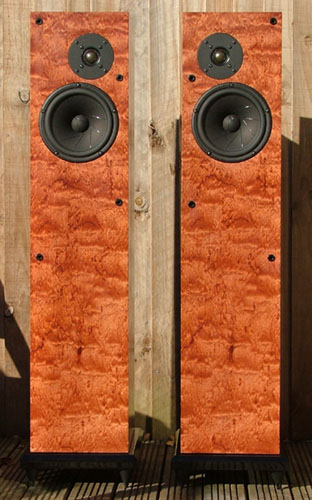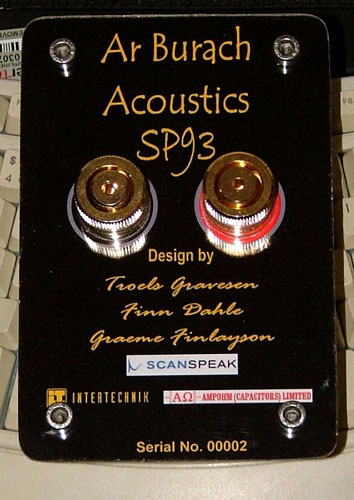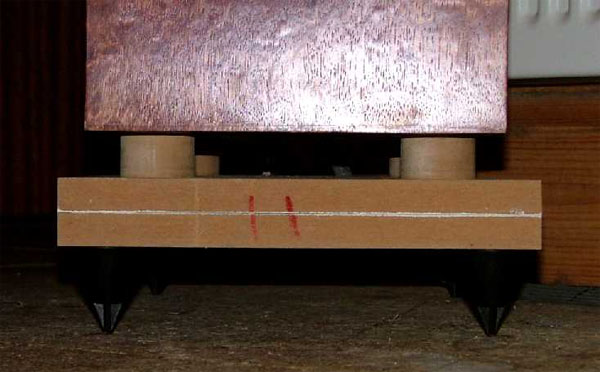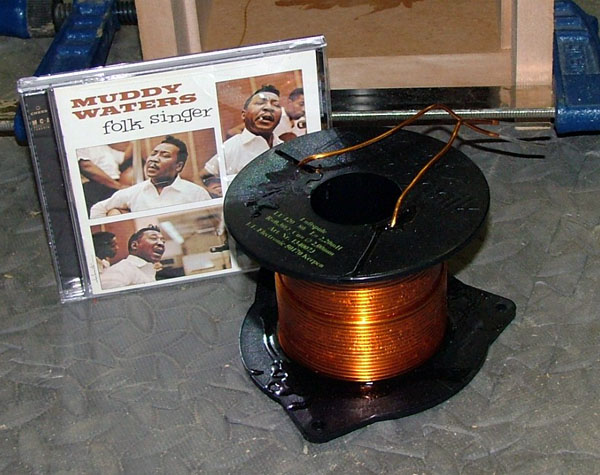The SP93 by Graeme
 
See all the pictures here:
Mail #1:
I thought I would drop you a line and update you on the
progress of my SP93's. My cabinets are well on the
way. All the panels and braces are cut and the
recesses are routed in. Surprisingly, they all fit
together quite well. Not bad for manual routing! I've
followed Finn Dahle's cabinet construction method - I
don't speak Norwegian, but I got the general idea from
the photographs and the few words I could
understand. The side panels, top and bottom are all
25 mm MDF. The inner front and rear panels are 18 mm MDF,
and the outer front and rear panels are 25 mm MDF.
All the internal bracing is 18 mm MDF.
I've gone for all air cored inductors from Intertechnik,
apart from the 3.9 mH in the notch filter which is an
Intertechnik ferrite core. The 2.2 mH inductors are
HUGE! I'm using Ampohm FP-CA-AU capacitors with Vishay
Roederstein MKP 1837 0.01uF bypass caps. The Ampohm
Capacitors are very reasonably priced over here and have
a very good 'sound'.
I'm just waiting on the drive units to arrive, so I can
assemble and test. If you like I can send
some photos of the various stages when they're assembled.
I'm going cover them in a bubinga hardwood veneer, which
has a very interesting 'waterfall' grain pattern. One
thing I'm not too sure about is how to attach the veneer,
as it's my first veneering project. There are so
many different methods. I see from your website
that you have veneered a number of speaker
projects. Which method do you use, and can you give
me some tips on how to proceed?
Best Regards,
Graeme
Mail#2:
I've finally finished the speakers. I e-mailed Bill Martinelli for advice on
the veneering. He recommended using a PVA based glue and
using a household iron to set it. If you look on
his homepage at the curved veneering there's alot of
information. As I was using raw veneer, I had to
flatten it first. I did this by spraying it with a
10% solution of glycerine in distilled water, and then
sandwiching the leaves between sheets of kraft paper
between some MDF boards which were weighted and clamped.
I changed the paper about twice a day for over a
week. I sanded the cabinets with 80 grit paper on a
random orbit sander to break the 'glaze' on the
MDF. It was then a matter of coating the cabinet
one panel at a time with glue - I used Titebond II with a
foam roller - and ironing the veneer on with a household
iron at a moderate heat setting (just below
cotton). The heat from the iron sets the glue and
locks the veneer in place. After trimming the veneer, I
sanded the cabinets with 240 grade, 400 grade, 600 grade
paper and then 600 grade wet 'n' dry with white
spirit. I then applied finishing oil, using a brush
for the first two coats, then 00000 grade steel wool
finish with a cloth for the remaining 6 coats to 8 coats
in total. I then finished off with 2 coats of
creamed beeswax applied with 00000 steel wool and
polished with a cloth.
The rear panel and plinths were sprayed with 4 or 5 coats
of MDF primer and 4 coats of black gloss enamel.
The plinths were then coated with 4 coats of spray
applied gloss polyurethane varnish.
I'm very impressed with the sound of these speakers, the
bass from the 8531s is just incredible! The bottom
porting seems to have worked well. One speaker is
relatively close to a wall, and the other is in free
space. Both sound well balanced, there's no 'boomy' bass
like that from placing a rear ported speaker near a wall.
The port tuning came out at 32 Hz, with a 405 mm port
length. I estimated the length from your port tuning
study, and was pleasantly surprised that it came out so
close. The midrange has a certain 'lushness' about it,
but I rather like the sound. The 9300 tweeter is silky
smooth and nicely detailed without being harsh.
Soundstaging is good - reasonably wide and with good
depth. The Ampohm capacitors with the MKP1837 bypass caps
really help to bring out the detail and atmosphere in
recordings. I used the crossover you designed for the
SP95, and it works very well. The frequency response
curve is quite good. I haven't mastered using the gated
MLS measurement technique in Speaker Workshop yet, so the
lower frequencies aren't that reliable, but overall the
FR plot is very similar to the plot you measured with the
SP95. Once I've figured out how to use SW properly, I'll
redo the FR testing.
I've put all of the photos together on a webpage. If you wish to
put some of them on your website, feel free to use any of
the photos. You can also link directly to them to save
your bandwidth. My ISP provides my webspace for free, and
they don't set any limits for traffic.
Thank you for sharing your designs!
Best Regards,
Graeme
Mail #3:
I've been listening to some more music today (mostly
jazz) and I've noticed that very low frequencies,
especially acoustic double bass seem over
emphasised. I am wondering, could this be because
of the bottom porting? Am I gaining a couple of dB
extra around the port frequency due to its close
proximity to the floor? If so, is there an easy way to
reduce it slightly? Perhaps shortening the port slightly
to raise its tuning frequency? I would welcome your
suggestions.
Best Regards,
Graeme
Mail #4:
I've done some experimenting in the last couple of
hours. I had a 1220 x 100 mm off cut of 25 mm MDF
which I cut into 16 pieces, so I could try 25 mm or 50 mm
of extra lift from the floor. 25 mm didn't have
much effect. 50 mm was marginally better.
I happened upon another idea - I have a granite slab
which usually sits on top of my CD player. I placed
this on top of a piece of anti-slip rubber mat under the
left speaker (the mesh stuff that you can use for holding
stuff for routing and for lining the drawers in tool
chests etc.), switched off the right monobloc power amp
and played the first couple of tracks of Muddy Waters'
Folk Singer. The double bass plays almost
exclusively from the left speaker. The recording set up
for this 1963 recording was very simple. Muddy Waters sat
in the centre with his guitar, Buddy Guy sat to the right
behind him on guitar, and Willie Dixon stood behind
and to the left of Muddy on acoustic bass. Clifton James
sat further to the left on drums. With the plinth under
the speaker, the boomy bass was gone. Both myself
and my wife listened to it with and without the plinth,
and we both agree.
Another factor which I didn't think of when building the
speakers is that our house has a suspended floor which I
guess is prone to resonance - the floor boards are laid
on beams which are suspended between the walls. I
suspect that a similar construction is used in Denmark
and probably Sweden, Norway and Finland to help with
insulation for your cold Scandinavian winters. Most
new homes in the UK have concrete floors which don't
resonate, so I suspect bottom porting probably works best
on concrete floors.
I have to confess this idea wasn't my own. I did
some searching for bottom ported speakers and came across
a high-end design which is bottom ported (If I can find
it again I'll send you the link). The manufacturer offers
an optional granite slab to sit under each speaker, at a
cost of about $600! Presumably the slab is intended
for use on suspended floors to prevent the bass
energy from causing unwanted resonances in the
floor. My granite plinth is a £12.99 worktop saver from
Argos! I'm curious to find out how they sound on a
concrete floor. One of my friends is keen to hear them.
It just so happens that he lives in a modern, concrete
floored house, so I may have to take them round to his
place for an audition - I'm not looking forward to moving
them, though. The cabinets with the drivers fitted weigh
in at 33 kg each.
I'll let you know my findings.
Regards,
Graeme
Mail #5:
After my experiments last night, I did some more
thinking. A more aesthetically pleasing way of decoupling
the port from the floor, would be to use a solid plinth,
and to have the port vent above the plinth by using
spacers. Similar venting is used by Polk on the
LSi25, by Audio Physic on the Yara, and by ProAc on the
D38.
A couple of hours with the table saw and router this
afternoon, and I've roughed out a suitable plinth:

It works very effectively. There's
still a little room gain in the low bass, but it has
reduced substantially compared to using the original
plinth. All I need to do now is trim the plinth a little,
fill it, sand it, apply lots of coats of primer, lots of
coats of black gloss and lots of coats of varnish :-(
For those who can place their speakers far enough from a
rear wall, I'd recommend using the standard rear-ported
design. For others, like myself, whose room layout
requires one or both speakers be closer to the rear wall,
then the bottom port is certainly worth trying. A more
standard sized port, say 70 mm or so may work better to
minimise the little bit of extra room gain. I used 102 mm
ID pipe because I had some lying around in the garage.
Best Regards,
Graeme

Mail #6: 14-03-2006:
I've done some more tinkering around with plinths over
the last week or so. I had a flash of inspiration and
started to think about the size of the port outlet around
the plinth. The speaker is 345 mm deep and 225 mm wide
and with 25 mm spacers between the base of the speaker
and the plinth, effective outlet area around the base of
the speaker is (34.5 +22.5)*2 - 16.0 (4 times 40 mm
diameter spacers)* 2.5 cm, which equals
158.75 cm^2, or the equivalent of a 14 cm diameter
port. As an experiment, I used smaller and smaller
spacers to reduce the effective port outlet area. I
measured the speaker iimpedance after each adjustment to
see if it was having any effect on the port tuning.
The results were very interesting - 25mm made no
difference compared to the original plinth, port tuning
stayed at 32 Hz, I tried 12 mm, still 32 Hz, at 6.4 mm
port tuning dropped to 31.5 Hz, and at 4.8 mm the port
tuning dropped to 31 Hz. For the 6.4 mm and 4.8 mm
spacings I used some M8 repair washers which are 1.6 mm
thick. At 4.8 mm spacing, bass is exceptionally well
controlled, very deep, very tight, midrange sounds much
clearer and the overall tonal balance is just right.The
washers are 25 mm diameter, so by my reckoning I still
have ((34.5+22.5) - (4*2.5))*0.48 or 50 cm^2 of port area
coupling with the room, which is equivalent to a port of
80 mm diameter.I may be talking out of turn, but my
empirical thinking leads me to beleive that larger ports
will give more room gain. The bottom porting works
well, but for this size of speaker and a bass rich driver
like the 8531, a 102 mm port was simply too big. If I
find the time in future, maybe I'll do a
study of the effect of different port diameters tuned to
the same frequency with the same driver/enclosure. If I
find some time over the next week or so, I'll update my
photo page to include some description of the
construction, testing and tuning.
Best Regards,
Graeme
|



